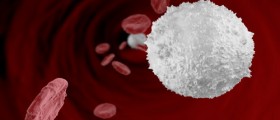Hematocrit and hemoglobin measurements are blood tests and they are a part of a complete blood count. A complete blood count, also known as full blood count (FBC) or full blood exam (FBE) or blood panel, is a specially designed blood test used to evaluate patients' overall health and detect various health problems and disorders such as infections, anemia and leukemia. A complete blood test measures a number of blood components and their levels.

Blood cells are generally divided into three types: white blood cells (leukocytes), red blood cells (erythrocytes) and platelets (thrombocytes). Hematocrit and hemoglobin measurements appear as a part of red blood cells measurements. Any kind of unusual increase or decrease in the levels of blood cells indicates that a patient suffers from an underlying medical condition and requires further investigation.
Hematocrit
Hematocrit or a packed cell volume is the fraction of whole blood volume that consists of red blood cells. In humans normal volume of red blood cells is somewhere around 48% for men and 38% for women. Hematocrit does not depend on individual’s body size. The packed cell volume is measured by centrifuging heparinized blood in a capillary tube at 10,000 RPM for five minutes. This process allows for separation of blood into different layers. The lower layer is composed of erythrocytes (red blood cells); the middle layer is composed of leukocytes and thromobocytes, while the top level contains plasma. By measuring the length of the lower layer, one can determine the packed cell volume in a blood test.
Low hematocrit levels are indicating anemia. Anemia is usually caused by malnutrition, loss of blood, or bone marrow problems. Elevated hematocrit levels may indicate a risk of dengue shock syndrome, polycythemia vera or chronic obstructive pulmonary disease. However, in most cases, high hematocrit levels are due to dehydration.
Hemoglobin
Hemoglobin is the oxygen-carrying protein in the red blood cells. Hemoglobin in the blood binds the oxygen molecules and transports them from the lungs or gills to the rest of the body. As the blood circulates trough the body, hemoglobin collects carbon dioxide to bring it back to the lungs, while completing the circle of the blood flow. In mammals, the protein makes up about 97% of the red blood cells' dry content, and around 35% of the total content. Normal levels in humans are dependent on the age and sex of an individual. Normal levels are:
Men: 13.8 to 18.0 g/dL (138 to 182 g/L, or 8.56 to 11.3 mmol/L) Women: 12.1 to 15.1 g/dL (121 to 151 g/L, or 7.51 to 9.37 mmol/L) Children: 11 to 16 g/dL (111 to 160 g/L, or 6.83 to 9.93 mmol/L) Pregnant women: 11 to 12 g/dL (110 to 120 g/L, or 6.83 to 7.45 mmol/L)Low hemoglobin count indicates lower oxygen carrying capacity of the blood. It can be associated with many diseases and conditions that affect the production of the red blood cells. However, it may be normal for some people, especially in young menstruating and pregnant women. A high hemoglobin count indicates an above-average concentration of oxygen-carrying proteins in the blood. However, this does not mean the patient has elevated number of red blood cells. It is still possible that patient suffers from anemia, for example.
- medlineplus.gov/lab-tests/hemoglobin-test/
- medlineplus.gov/lab-tests/hematocrit-test/
- Photo courtesy of Phillip Jeffrey by Flickr: www.flickr.com/photos/tyfn/8057597193/

















Your thoughts on this
Loading...